Action Plan for Construction and Demolition Waste to be Adopted in Autumn
ZAGREB, 10 July 2022 - An action plan for construction and demolition waste is to be adopted in the autumn, and this has been chosen as a priority for efforts to switch to the circular economy, the head of the sustainable waste management department in Croatia's economy ministry says in an interview with Hina.
The official Sanja Radović has told Hina in the interview published on Sunday that the preparation of the five-year action plan for the circular economy has been supported by the World Bank.
Recently, a committee for the circular economy has been set up.
According to Radović, as much as 70% of the construction and demolition waste can be re-used and recycled.
Construction and demolition waste has been selected as a priority also because of the 2020 devastating earthquakes in Zagreb and Sisak-Moslavina County, which also resulted in higher quantities of building debris.
Construction and demolition waste management is also within the remit of local authorities that are supposed to introduce an organised system.
The units of local authorities are supposed to determine drop-off locations where construction and demolition debris can be disposed and choose waste sorting and recycling tools for that purpose.
Sorted construction waste can be reused in the construction industry.
In the quake-hit Banovina area in Sisak-Moslavina County this process is already applied, and the City of Zagreb is expected to start doing that in the autumn.
Currently, Croatia sorts out 35% of all the waste, said Radović.
The aim of the circular economy is to reduce the quantity of non-recycled waste to the lowest possible level.
(Hina) ms
RokOtok 2022: A Father's Love, Swimming to Over 50 Inhabited Croatian Islands
July 10, 2022 - One of the most beautiful tributes I have ever come across enters its third and final year, as RokOtok 2022 attempts to connect 50 inhabited Croatian islands by a loving father in a unique tribute for his son.
I have met many incredible people during my time in Croatia, and we have reported on a number of incredible projects. And sometimes - just sometimes - those incredible people can be found executing incredible projects. And then you have something truly special.
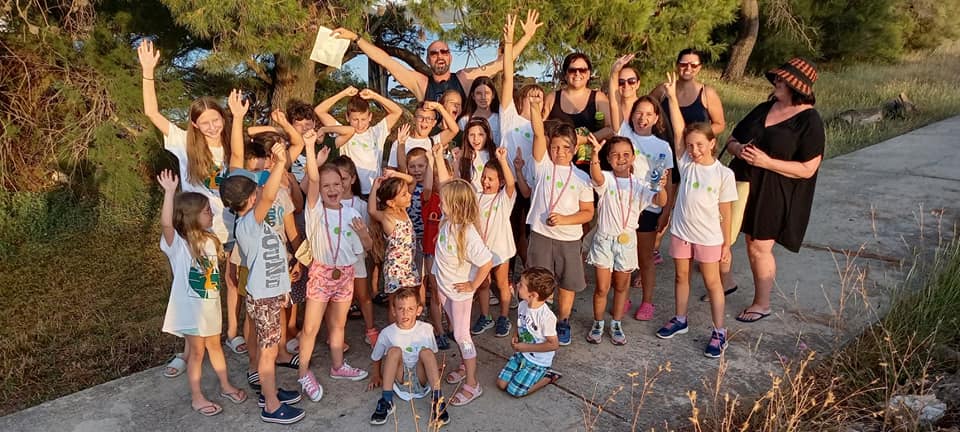
I first came across Domagoj Jakopovic, aka 'Ribafish' several years ago. As one of the instigators and participants of one of Croatia's coolest events, which has gone down in folklore - the legendary Ilicki Maraton, a drinking challenge the length of Zagreb's longest street 14 years ago - we had some Facebook messenger correspondence about resurrecting the marathon for a 10th anniversary appearance. Nothing came of it, and we never met.
Time passed, and then three years ago, I got a message that Ribafish was SWIMMING to Jelsa as part of a project to connect all Croatia's inhabited islands by swimming from top to bottom, and I would be able to meet him for an interview. I quickly went into research mode, and this is what I found about the RokOtok project:
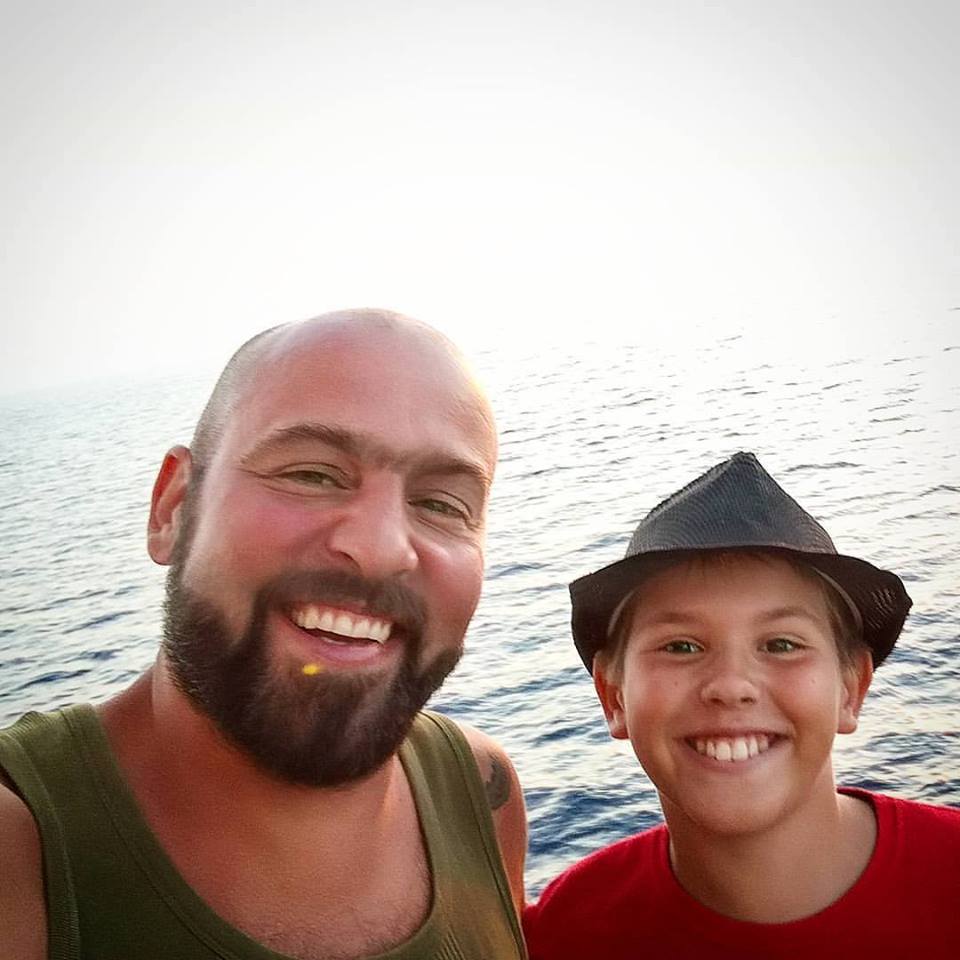
RokOtok is a project created in memory of Rok, a curious and cheerful boy who planned to visit all Croatian inhabited islands with his father, but the adventure was abruptly interrupted at the age of thirteen, when Rok left this world. His father, Domagoj Jakopović, better known as Ribafish, decided to fulfill his promise to his son, swim from island to island, continue the story and include other children and parents in it in order to achieve their never-ending life project together.
The aim of the project is to raise awareness of the importance of the time that parents spent with their children through sports, play and learning, and to develop and encourage children's curiosity, interests and research spirit. And precisely through games and activities with parents, he plans to teach the kids about the cultural and natural heritage of each island he visits. Additionally, through specially prepared ecological workshops, Ribafish will point out the importance of preserving the environment, with a special emphasis on ecological waste disposal.
Rok's ashes were thrown into the Adriatic, close to their favourite beach on Korcula, so that he could be with his father on this epic and very personal journey. It was one of the most heartwarming stories I have covered on TCN, and you can read that initial interview and all the young lives he touched in RokOtok by RibaFish: The Most Heartwarming Project in Croatia in 2019.
A truly inspirational man, and a very funny one too. I hadn't realised what a coup I had by doing a video interview of Ribafish in English - his legion of fans were thrilled as they had never heard him speak English before - he does so very well (see the video above).
Riba and I have become good friends since, and I watch with envy at his energy travelling all over the country discovering the finest food and wine novelties on a seemingly daily basis, but I know that his focus has been on completing his journey with Rok. The original plan - to swim all 50 islands from south to north over three summers, was delayed due to the pandemic in 2020, and so RokOtok 2022 is the final leg.
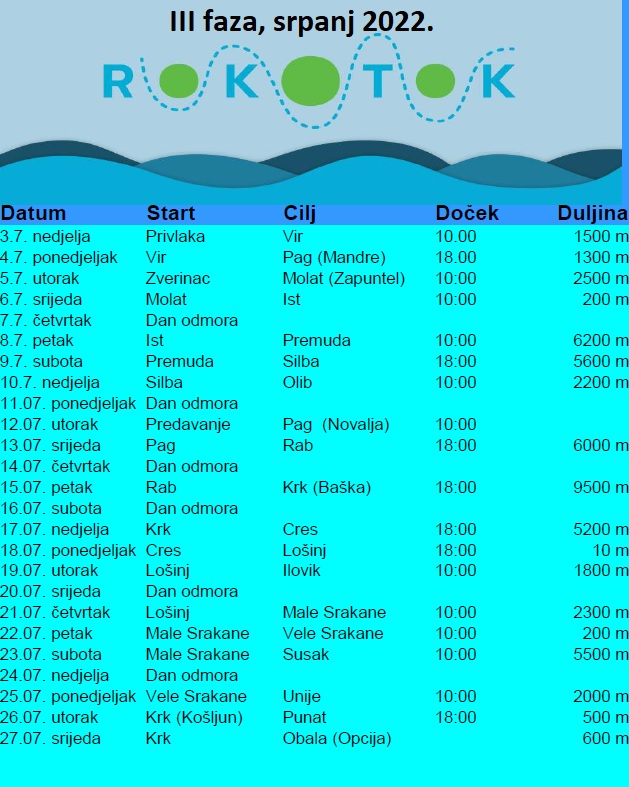
Riba set off on RokOtok last Sunday, from Privlaka to Vir, and this morning swam into the island of Olib. Each destination has a welcome committee, including many children who come to hear his message. If you happen to be holidaying on any of these islands, I do encourage you to stop by. The penultimate column in the schedule above is the estimated time of arrival, and you can see how far the swim is that day in the last column.

Swim well, Riba, and see you for a glass of wine or three in Slavonia soon.
You can keep up to date with the latest from RokOtok 2022 on the event Facebook page - please contact them if you would like to make a donation.
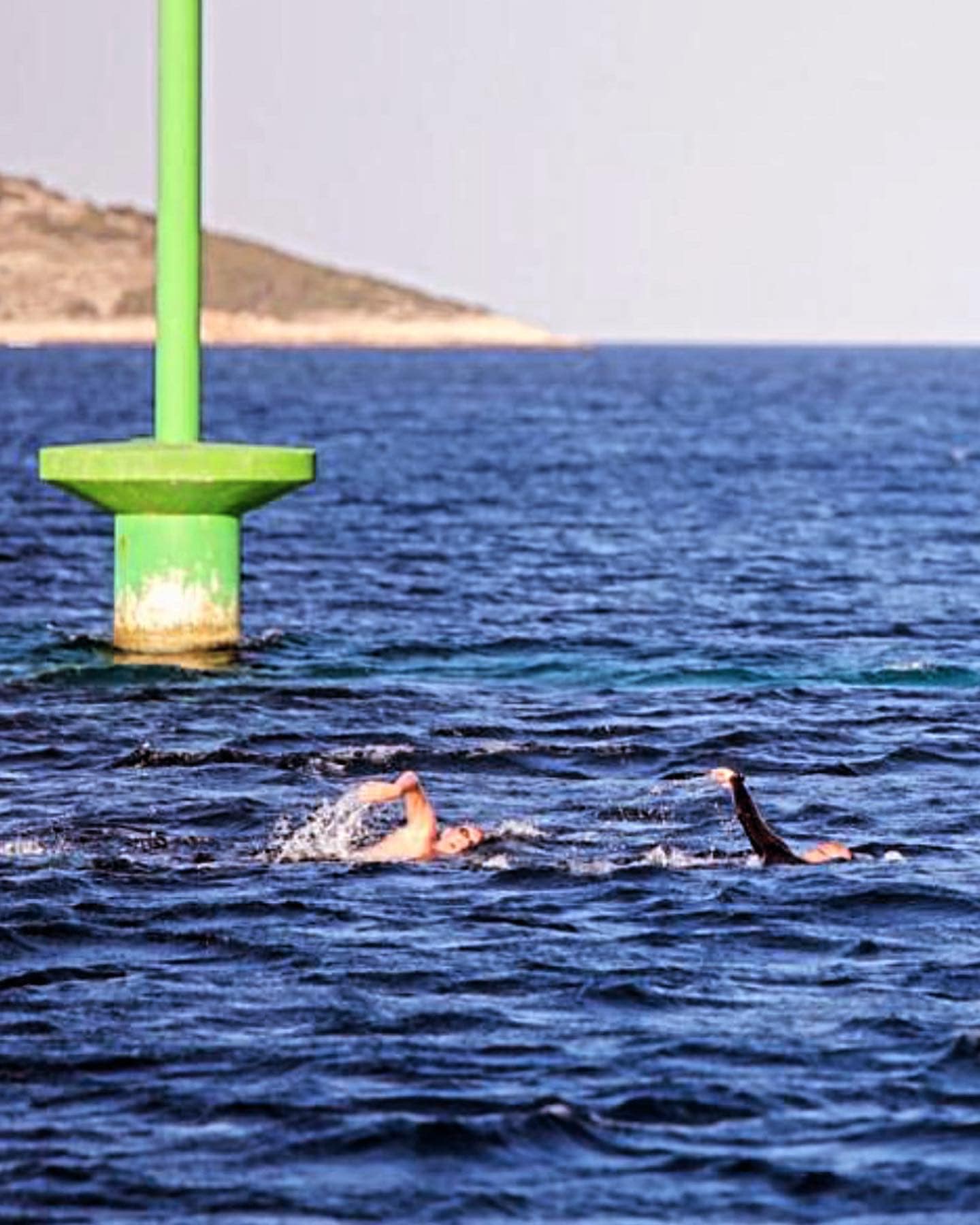
Ecofin to Make Final Decision on Croatia's Entry into Euro Area on Tuesday
ZAGREB, 10 July 2022 - The Economic and Financial Affairs Council for EU (Ecofin) convenes on Tuesday to adopt the final three legal acts which will enable Croatia to introduce euro as its currency on 1 January 2023.
One of those three acts concern the decision on the adoption of the euro by Croatia.
Also the amendment will be adopted to the provision whereby the 19-member euro area will welcome Croatia as its 20th member. Currently the euro area has more than 340 million inhabitants and is the second strongest economy globally. The euro zone accounts for 15% of the global GDP.
And, the third legal act concerns the fixing of the conversion rate of the kuna for the euro.
The outgoing minister Zdravko Marić will attend the Ecofin meeting in Brussels for the last time in his capacity as the Croatian minister of finance after he recently resigned from the government.
Deeper integration
Entering the euro area is one of the remaining two strategic goals for Croatia's deeper integration in the European Union. The other goal is the country's admission to the passport-free Schengen Area, and the decision to this effect is likely to be adopted in September.
As a result, Croatia is to complete its deeper integration into the EU in 2023, ten years after it joined the European Union.
Croatia's fulfillment of all convergence criteria for euro area
On 16 June 2022, the Eurogroup endorsed the positive convergence assessment of Croatia, agreeing that Croatia has fulfilled all convergence criteria required to join the euro area, proposing that Croatia should introduce the euro on 1 January 2023.
The Eurogroup's move ensued after on 1 June both the European Commission and the European Central Bank (ECB) issued the convergence reports informing the EU Council about the progress made by Member States towards achieving the criteria for joining the euro area.
One of the four criteria is price stability.
Furthermore, the aspirant is expected to have sound and sustainable public finances which means that the country should not be under the excessive deficit procedure.
Also, exchange-rate stability is one of the criteria and under this criterion the country has to participate in the Exchange Rate Mechanism (ERM II) for at least two years, without strong deviations from the ERM II central rate and without devaluing its currency's bilateral central rate against the euro in the same period.
And finally, long-term interest rates are included in the criteria, which should not be higher than two percentage points above the rate of the three best-performing member states in terms of price stability.
In both reports on 1 June, Croatia received a very favourable assessment: not only did Croatia meet all the criteria, but the sustainability of its convergence has been assessed more favourably by the ECB than in its 2020 report and much more favourably than in its earlier reports.
The reports highlight that the Croatian legislation is compatible with the EU Treaties and the Statute of the European System of Central Banks and of the European Central Bank.
Croatia was assessed more closely than the other countries under review, given the fact that the Croatian authorities have announced their intention to adopt the euro as of 1 January 2023.
HNB enters Eurosystem, monetary authority of euro area
Croatia's entry into the euro area also means that the Croatian National Bank (HNB) enters the Eurosystem, which comprises the European Central Bank (ECB) and the national central banks of the Member States whose currency is the euro.
The Eurosystem is the monetary authority of the euro area with its primary objective being the maintenance of price stability for the common good. Acting also as a leading financial authority, the Eurosystem aims to safeguard financial stability and promote European financial integration.
The ECB has the central role in the Eurosystem, and the main body of the ECB is its six-member Executive Board which consists of the President, the Vice-President and four other members. All members are appointed by the European Council, acting by a qualified majority.
The ECB Governing Council is the main decision-making body of the ECB. It consists of the six members of the Executive Board, plus the governors of the national central banks of the euro area countries.
Dual price display
In September, the four months prior to the switching to the euro, the obligation of dual price display both in national currency (kuna) and the euro goes into effect in Croatia.
The two-week period of dual circulation of both currencies will run as of 1 January.
Coins produced in Croatia
Euro banknotes are taken from the ECB, while euro coins will be produced in Croatia. Euro banknotes are identical in all the euro zone's members, while the euro coins have national sides with national symbols.
There are eight euro coin denominations, ranging from one cent to two euros.
Concerning Croatia's symbols, all coins will have the Croatian chequerboard in the
background.
The coin of 2 euro also includes Croatia's map, the coin of 1 euro has the motif of marten, 10c, 20c and 50c coins have the motif of researcher Nikola Tesla, while 1c, 2c, and 5c coins have the HR letters written in the Glagolitic script.
Coins with the Croatian national side can start to be minted once the Council of the EU adopts a decision on the introduction of the euro in the Republic of Croatia.
(Hina) ms
Split Holding Mayoral Runoff Election
ZAGREB, 10 July 2022 - Over 160 polling stations were opened on Sunday in Split for the second round of the snap mayoral elections in which Ivica Puljak of the Centar Party and Zoran Đogaš, an independent supported by the HDZ and HSS parties, are vying for the mayoral post in the second biggest Croatian city.
The first results of the runoff will be announced by the State Election Commission (DIP) after 2000 hrs Sunday.
In the first round of the early polls 14 days ago, Puljak finished as first and was short 1.3 percentage points for the outright victory. Đogaš came second with 25.67% of the vote on 26 June.
The other seven mayoral candidates won below 10% of the vote in the first round of the polls: Željko Kerum of the HGS (7.94%), Josip Markotić of the Bridge party (4.53%), Aris Zlodre of the Homeland Movement (3.89%). Davor Matijević of the Social Democratic Party (3.84%), Tamara Visković of the We Can and the New Left (1.85%), Kristina Vidan of Pametno za Split i Dalmaciju (1.28%) and independent Ante Franić (0.66%).
An early election was also held for the 31-seat city council on 26 June, and according to the returns from the polling stations, the Centar party won 42.47% of the vote. The slate of the Croatian Democratic Union (HDZ) and the Croatian Peasant Party (HSS) follows with 23.81%, while the HGS party of former mayor Kerum ranks third with 7.11% of the vote.
The other three slates that passed the 5% threshold are Bridge with 6.61% of the vote, the SDP/HSU with 5.75%, and the Homeland Movement (DP) with its partners HDS, HSP and Sovereignists (5.63%).
The turnout was 31.6% on 26 June.
The snap elections for the mayor and the city council were held 12 months after regular local elections in Croatia in May 2021. The early polls were called after Mayor Puljak and his two deputies tendered their resignations on 8 April following a scandal involving Deputy Mayor Bojan Ivošević, who threatened a local reporter and was subsequently indicted for intimidation on 23 March.
After their resignations, the members of the 31-seat city council also stepped down, paving the way for an early election for the city council.
(Hina) ms
80th Anniversary Of Diana Budisavljević's Children Rescue Action Marked
ZAGREB, 10 July 2022 - The 80th anniversary of the rescue operation launched by Diana Budisavljevic who played a crucial role in saving Serb children and finding a foster home for about 1,600 of them in Zagreb during the WW2, was marked in the capital on Saturday evening.
The commemorative event was held in a yard in downtown Zagreb where a majority of the saved children had been brought from Ustasha-led concentration camps to be taken by their foster families.
The commemoration was organised by the Documenta nongovernmental organisation, the Serb People's Council (SNV), and the Jasenovac Memorial Centre in memory of 10 July 1942 when humanitarian Diana Budisavljević arrived in the NDH-led Stara Gradiška camp and started registering children in a bid to save them.
Documenta leader Vesna Teršelič said that Budisavljević had actually begun her operation in October 1941 as soon as she had got information about the camps in Loborgrad which prompted her to do something and rescue children from those camps.
The commemorative events are also scheduled for Sunday, 10 July.
Teršelič said that Croatia was still dealing with many challenges concerning the legacy of the Nazi-style Independent State of Croatia (NDH), and warned that the For the Homeland Ready salute and Ustasha insignia had not yet been outlawed.
She expressed satisfaction with the attendance of young people from Italy, Germany, Greece, Ukraine, and Slovenia at the commemoration, within the EU-supported project "Between Memory and Oblivion - WWII places of memory".
Born in Innsbruck in 1891, Diana nee Obexer married Julije Budisavljevic in 1917, who at that time worked as an assistant at the surgical clinic in Innsbruck. By 1919, the couple had moved to Zagreb. She lived in Zagreb with her husband until 1972, when they moved back to Innsbruck. She died on 20 August 1978, aged 87.
In 2020, researcher and historian Natasa Matausic issued a book about Diana Budisavljevic in which she writes that this humanitarian woman of the Austrian ethnic background saved about 7,700 children from homes and Ustash-run camps during WWII.
To the Hills! 1st Zagreb Mountain Summer Film Festival This Week
July 10, 2022 - Feeling a little warm in the city? Head to the hills this week for the first Zagreb Mountain Summer Film Festival.
One of the cool things I have come across since following Zagreb tourism is how a little innovation and thinking out of the box can produce some quite exceptional tourism experiences at little additional cost. A good example of this would be the Zagreb County Tourist Board initiative, Via Vino, last October, when the county's wineries combined open cellars with art, music, culture, and film. One very cool event was the screening of the new James Bond movie outdoors in a vineyard, sitting on straw bales under blankets, eating roast chestnuts washed down with the local young Portugiesac wine.
An unforgettable experience.
And film is the main topic of the next cool little event to come from nowhere, the inaugural Zagreb Mountain Film Festival, which kicks off this Wednesday, July 13, with 5 nights of music, film, culture, and fun, fun, fun.

Where else can you get a mountainside pop up Museum of Illusions, for example? Or one of the popular digital nomad we{dn}esdays meetups with Digital Nomad Association Croatia?
This unique film festival is all taking place in the beautiful surroundings of Nature Park Medvednica, on the meadow in front of Snow Queen Hotel (Aparthotel Snjezna Kraljica) in the woods. The progamme is on the flyer above, or for more information, check out the Facebook event page.
You can get there via the new Sljeme cable car, bus number 140 from Mihaljevac, or take a Bolt or Uber. You are advised to bring your own blanket and a jacket or sweater, as the air can get a little fresh in the evening.
Zagreb Mountain Summer Film Festival is organised by Urban Entertainment and the Zagreb Tourist Board.
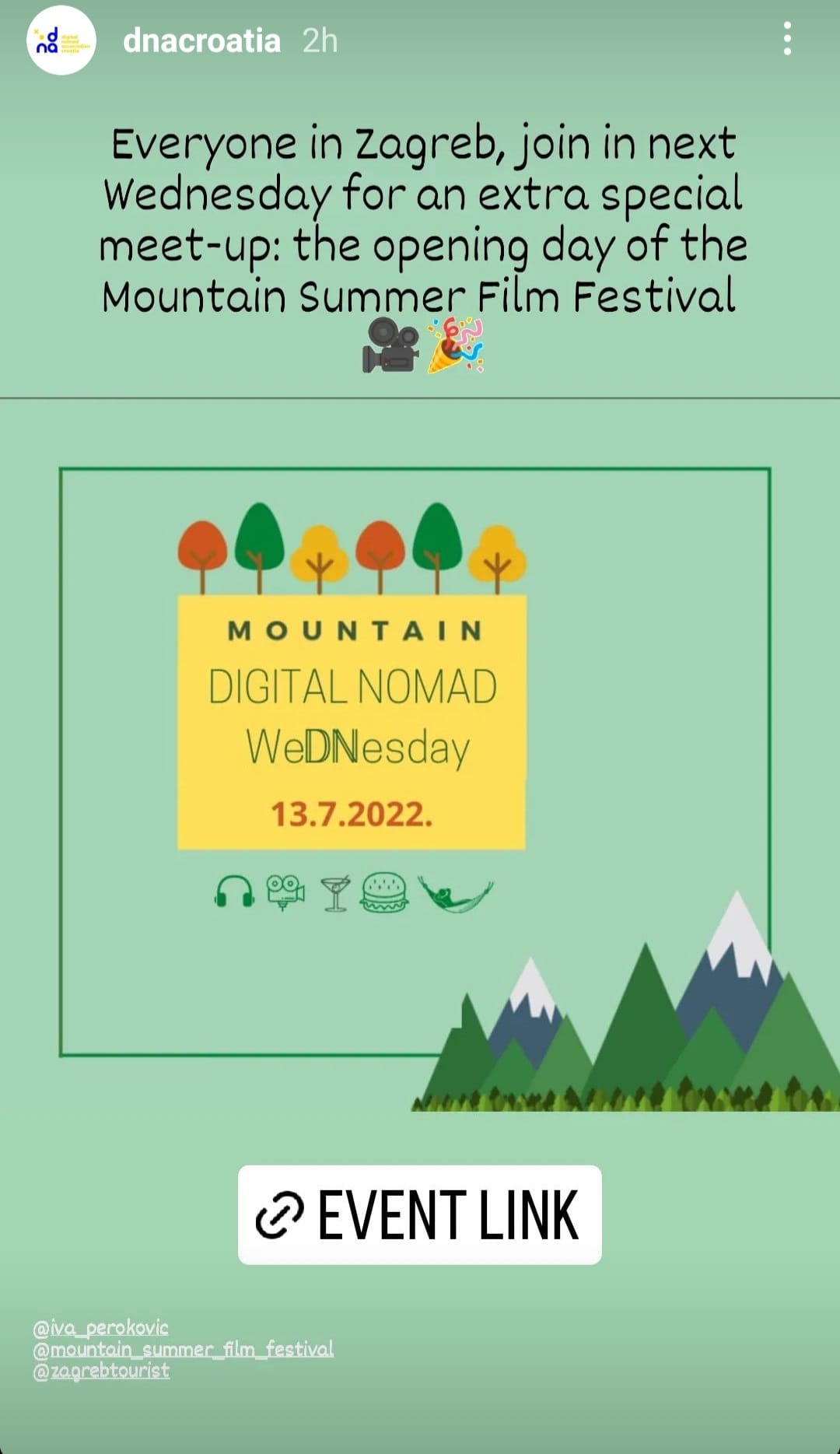
Looking to learn more about the Croatian capital? Check out the comprehensive Total Croatia Zagreb in a Page guide.
20 Ways Croatia Changed Me in 20 Years: 2. Olives
July 10, 2022 - Twenty years a foreigner in Croatia. Part 2 of 20 Ways Croatia Changed Me in 20 Years, and where would life here be without olives?
Back in 2002, my relationship with olives extended little further than knowledge of the phrase 'to extend an olive branch' and eating the token olive in the centre of a takeaway pizza. Olive oil was just something I never came across, and if I had consumed more than half a litre in the first 33 years of my life, I would be surprised.
All that changed with the fateful (and excellent) decision to buy a house and move to Hvar in 2002. As my 20th anniversary in this beautiful land approaches next month, the second installment of 20 Ways Croatia Changed Me in 20 Years, after yesterday's Business and Dalmatia.
2. Olives
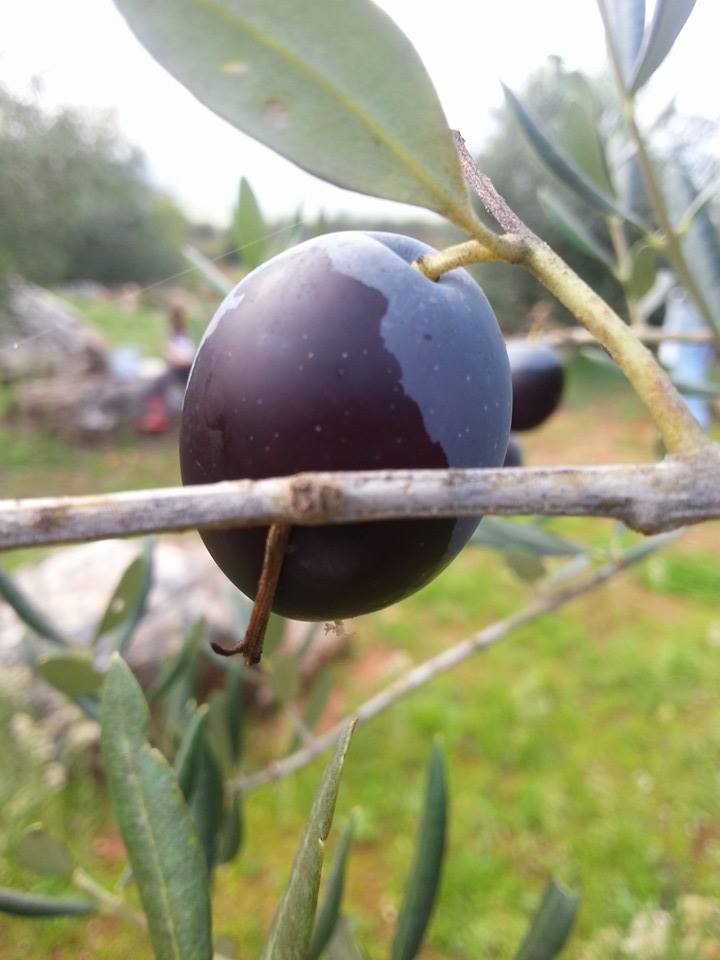
One of the many benefits of being a Dalmatinski Zet (Dalmatian son-in-law) is the wonderful home cooking of one's wife and mother-in-law. And - like most Dalmatian families - a proportion of the food on the table came from the family field. Unlike the insipid vegetables available 24/7, 365 days a year in Manchester supermarkets, here was high-quality fresh produce with real taste and colour, only available in the season that Mother Nature intended.
And laced with olive oil.
This golden liquid, with which I was so unfamiliar, was simply EVERYWHERE. A salad without a generous helping of olive oil was simply impossible. It did not take me long to adapt, or to understand why the Hvar Mediterranean diet was awarded intangible UNESCO heritage status back in 2013. With fresh food and quality olives and olive oil, no wonder people here seemed much more contented with life.
And the domestic olive oil has always been a highly-prized gift when visiting friends. Eyes light up when they accept a litre of home-produced olive oil from the island of Hvar. As well they might.

But while my diet has undoubtedly changed for the better with the liberal addition of olive oil and other tasty Dalmatian gourmet wonders, olives changed me more for a different reason during my time in Croatia, and they taught me one of the most important lessons about life there - the strength of community and tradition. For one cannot claim to have truly experienced Dalmatia without having participated in one of its most sacred activities.
The olive harvest.
I used to hate the olive harvest. Our family has a field which includes a vineyard and about 80 olive trees, which have been lovingly tended for years by my late father-in-law. Helping out at the olive harvest is expected, and I used to help out between work, but never really see it as more than a chore. Manual labour in the fields is not my forte.
But then something changed, gradually for sure, but with an intensity once we left the island and moved to Varazdin 6 years ago. I felt the need to connect and take part in the olive harvest, not so much as a chore, but as part of the community and tradition. When I moved to Hvar, the idea of standing in a field for days picking olives would have been my idea of hell, but now it is a time of year I look forward to, and I certainly feel 'the call of the olives.'

About 15 years ago, I was doing a presentation to the management board of one of Croatia's biggest companies, whose board included a senior member from my adopted hometown of Jelsa. It was October and his colleagues were joking that it was good I had come this week, as next week he would have been unavailable, as he had to tend his fields. There was a smile and a look of longing in his face, a quiet satisfaction that he would be trading in his suit for his overalls, leaving corporate Zagreb for a while to be close to the earth and the family olives. It is one of the many moments of my time in Croatia I will never forget, for while I did not quite understand his emotions at the time, I totally do now, as the culture of that marvellous golden liquid has clearly entered my veins over the years.
The Dalmatian olive harvest is about much more than olives. It is about community, of extended families, young and old, coming together to help out, socialise, and continue a tradition that has lasted millennia. The picking is hard work, but it soon becomes routine as you enter a rhythm, and with a whole field to choose from, you can choose a picking partner you have not caught up with for a while. And what a great experience for the little ones, who get yet one more opportunity to cement their bond with nature. Kids help out with a little picking, carrying empty crates, helping moving the sheets on the ground, and then running around in an extended and very safe playground under the watchful eye of their olive-picking parents. An affinity with Nature you just can't find in Manchester.
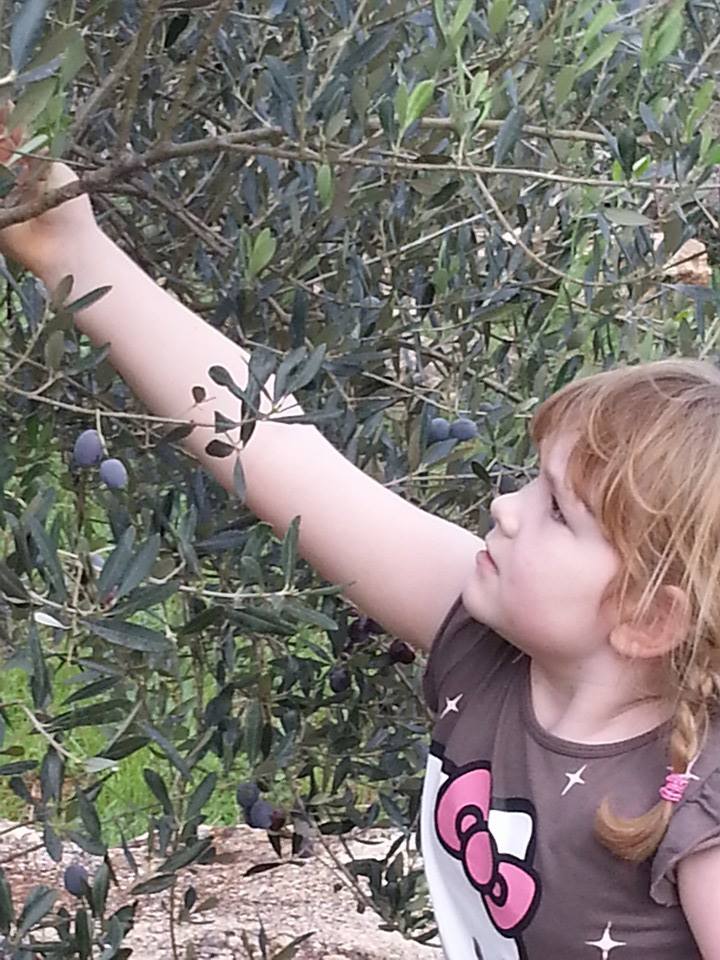
It is a truly beautiful sight driving from Jelsa to Stari Grad in late October to see ageing Renault 4 and similar cars parked sporadically at the side of the road, close to fields where whole families are busy picking the family olives. A whole island harvesting the gifts that Nature gives them every year, as it has done for more than two millennia.
Extended families recalled from the mainland by the call of the olives.
Community.
Timeless.
I love it.
Hard work should be rewarded, of course, and a full day's picking is rewarded by a feast fit for kings. Like many other fields, ours has a rustic hut, which is primarily used for storage and a little hideaway to enjoy social gatherings.

Pride of place is the grill, of course, and tired but happy olive pickers will head inside as the last of the olive-picking light fades to rest and reflect on a successful day over grilled fish and a glass or three of wine. These are some of my very favourite meals in Croatia, simple in their preparation, superb in their taste. Fresh fish on the grill, laced in - you guessed it - olive oil (they say that fish in Dalmatia swim three times - firstly in the sea, then in olive oil during preparation, then washed down with fine Dalmatian wine).
Salads laced in - you guessed it - olive oil are usually prepared in advance, with ingredients from the field of course. And there is bread, which can be used to soak up - you guessed it - olive oil to add to its taste. Wine in 2-litre plastic bottles that used to contain Coca-Cola, pressed from grapes in the field. A 100% fabulous and very cosy Dalmatian culinary experience, with only the bread, and fish from the nearby Adriatic not coming from the field.
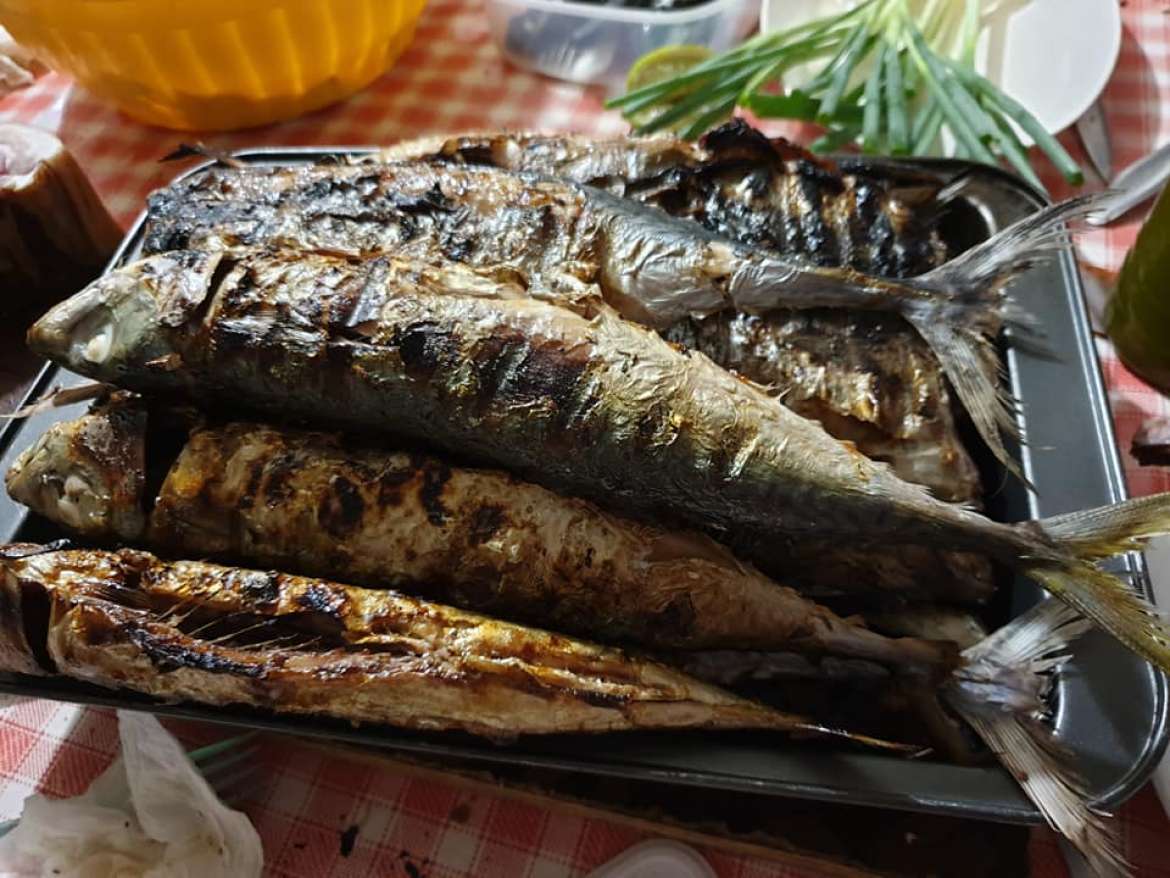
Dalmatian cuisine at its finest.
Before I improved my understanding of Dalmatia, I used to rail against the pure economics of the whole olive harvesting experience. A litre of oil used to cost 70-80 kuna, or around 10 euro. The family trees would give around 200 litres a year, enough for the family consumption for the whole year (remember that half a litre max for the first 33 years of my life, before moving to Croatia). So about 2,000 euro in total. Then deduct all the time maintaining the trees over the years, as well as the time of about 8 pickers full-time for 5-6 days, the cost of the magnificent lunches, the transport costs of those answering the call of the olives from Zagreb and beyond. Surely it would be more economical and less stress to simply keep working during that time and buy the oil elsewhere?
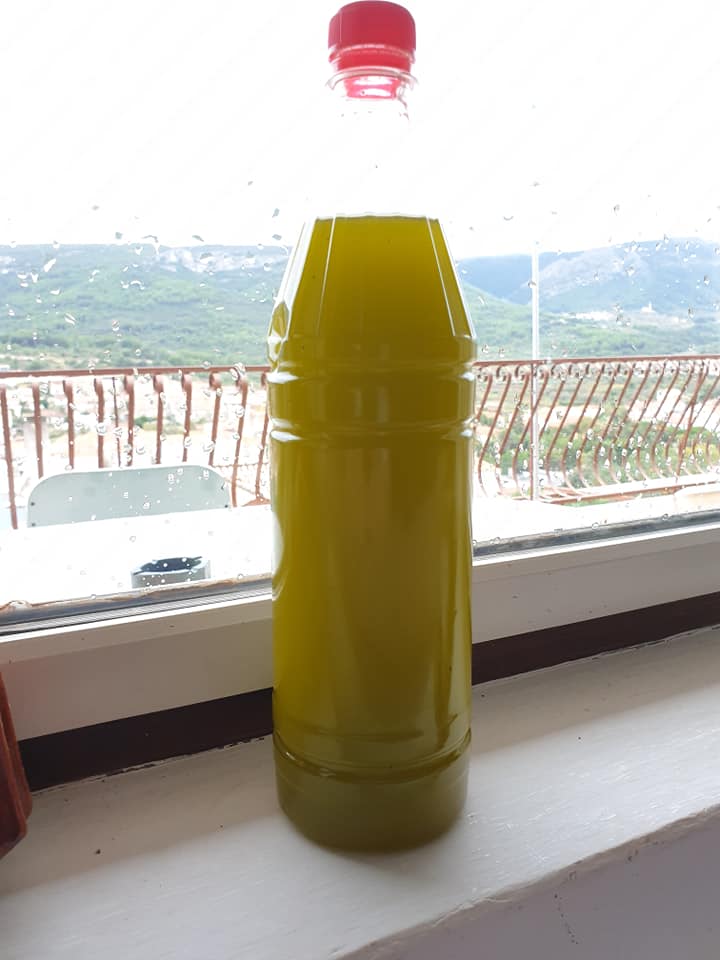
But, as we drove on the motorway back to Varazdin, with 10 litres of freshly pressed oil in the back of the car as our share for helping out, I realised that while it might only have a street value of 100 euro, those ten litres and the experience to produce them were the keys to the heart of Dalmatia itself.
And that, my friends, is priceless.
****
What is it like to live in Croatia? An expat for 20 years, you can follow my series, 20 Ways Croatia Changed Me in 20 Years, starting at the beginning - Business and Dalmatia.
Follow Paul Bradbury on LinkedIn.
Croatia, a Survival Kit for Foreigners will be out by Christmas. If you would like to reserve a copy, email This email address is being protected from spambots. You need JavaScript enabled to view it. Subject 20 Years Book
Mili Poljičak Becomes First Croat to Win Wimbledon Juniors Title!
July 10, 2022 - Young Croatian tennis player Mili Poljičak, who will turn 18 in three days, has won the Wimbledon Juniors tournament!
In the final match, the young Split tennis player and the tournament's third seed defeated American Michael Zheng 7-6(2), 7-6(3).
Poljičak thus became the third Croatian tennis player in history to win a junior Grand Slam tournament. Previously, Marin Čilić succeeded in this in 2005 at Roland Garros and Borna Ćorić in 2013 at the US Open. Croatian female tennis players, on the other hand, have six triumphs in junior competitions.
The first set lasted almost an hour, and Zheng was the first to break. He first went up to 3-2 and then what seemed like an unattainable 5-2.
However, Poljičak was able to recover. Zheng served for the first set, which then went to a tie-break. Poljičak immediately made a mini-break. He subsequently escaped to 6-2 and quite convincingly won the final fight to win the first set.
In the second set, Zheng was the first to break and took a 3-1 lead. However, after missing two break points in the fourth game, Poljičak went 0-40 at 2-3. He used the third break point in that game and tied it to 3-3.
Poljičak was dangerous in the second set when leading 4-3 and 5-4, but the American somehow brought it to a new tie break.
Poljičak again held everything in his hands. He led 2-0 and 4-1 and firmly held his service until the end and a great victory. Both players made two breaks each, with Zheng having two break chances and Poljičak eight. The Croatian junior had a first-serve percentage of 80 percent and won six points more than his opponent (88-82).
Poljičak thus became the first Croatian tennis player to win the Wimbledon Juniors tournament. Croatian tennis has had two finalists so far, but both lost in the final - Ivan Ljubičić (1996 to Vladimir Volčkov) and Mario Ančić (2000 to Nicolas Mahut).
Poljičak also won the junior doubles tournament at Roland Garros this year with Lithuanian partner Edes Butvilas.
Source: HRT
To read more about sports in Croatia, follow TCN’s dedicated page.
Sinković Brothers Take First at World Rowing Cup in Lucerne!
July 10, 2022 - Brothers Martin and Valent Sinković have taken first in the men's double sculls final at the World Rowing Cup in Lucerne!
After being the fastest in the semi-final race on Saturday, the Sinković brothers achieved another victory with a result of 6:07.19! Second place was taken by the Australian crew of David Bartholot and Caleb Antill (6:08.10). Aleix Garcia Pujolar and Rodrigo Conde Romero from Spain (6:08.56) took third.
Fourth place was taken by the Lithuanian crew (6:10.03), fifth by the British crew (6:11.44), while the Serbian crew finished last with a time of 6:15.53.
The Croatian rowers were ahead from the beginning of the final race and took the lead in the fight where the Australians David Bartholot and Caleb Antill were a serious and constant threat.
However, at every passage, from 500 to 1000 and 1500 meters to the finish line, the Sinković brothers were slightly ahead of the Australians. They repelled all their attacks, kept a constant fierce rhythm, and in the end celebrated with a winning time of 6:07.19.
The famous Croatian rowers have thus won the first and second World Cup and secured the title of overall winners even before the regatta in Lucerne.
Croatia's sister rowing team Ivana and Josip Jurković won fifth place in the coxless pairs final in Lucerne.
The Jurković sisters rowed the 2000 m section in 7:11.92 minutes. The New Zealand crew won with a time of 6:56.51. Silver was won by the Romanian crew (6:56.62), and bronze by the Great Britain crew (7:00.76).
Ivana and Josipa Jurković started the race well and were in third place on the first pass at 500 meters. They then fell to fourth and fought until the end with the Czech crew, who nevertheless finished fourth (7:00.74), while the Croatian crew had to settle for fifth. Only the Canadian women placed behind the Jurković sisters.
More soon...
To read more about sports in Croatia, follow TCN’s dedicated page.
How Does the Croatian Political System Work? A Brief Overview
July 10, 2022 - TCN contributor Kristian Divander breaks down the basics of the Croatian political system.
In Croatia, complaining about the politicians and the political system is a national sport, but what do folks know about the Croatian political system? Do they know what they are complaining about? Let’s find out!
Croatia is a parliamentary republic, which means that the prime minister (predsjednik vlade/premijer) and the government (vlada) is elected by the parliament, which is elected by the people. The role of the president (predsjednik države) is largely ceremonial. However, the president is the Supreme Commander (vrhovni zapovjednik) of the Croatian Army (HV). Moreover, the president has the power to dissolve the parliament.
The Sabor is the national parliament. It has 151 seats, eight of which are reserved for the national minorities and three for the diaspora. Three of the national minority seats are reserved for the Serb minority. The members of parliament (saborski zastupnici) are elected in 10 electoral districts. If a political party gets at least 4% of the votes in one of the electoral districts, it enters the Sabor. This means that a political party can receive less than 4% nationally and still win representation in the parliament.
Croatia is divided into 21 counties, or županije. Each županija is led by a county prefect, or župan, who is elected by the people. The regional parliament, županijska skupština, is also elected by the people. The City of Zagreb (Grad Zagreb) enjoys a special status, and is both a county and a city (grad).
Croatia has 127 cities (gradovi) and 428 municipalities (općine). Each city, grad is led by a mayor (gradonačelnik) and each municipality, općina by a municipal mayor (općinski načelnik). All city and municipal mayors are elected directly by popular vote, just like the president and the county governors. Each city and municipality has an elected council (gradsko/općinsko vijeće). The City of Zagreb, which is both a city and a county, has a city assembly (gradska skupština).
Each city and municipality is divided into districts (mjesni odbori). In Croatia, city and municipality district councils are elected by popular vote. They are elected by the residents of the city district (gradska četvrt). Just like other elections, city and municipality district council elections take place every four years.
Get it, now?
For more, make sure to check out our dedicated politics section.


